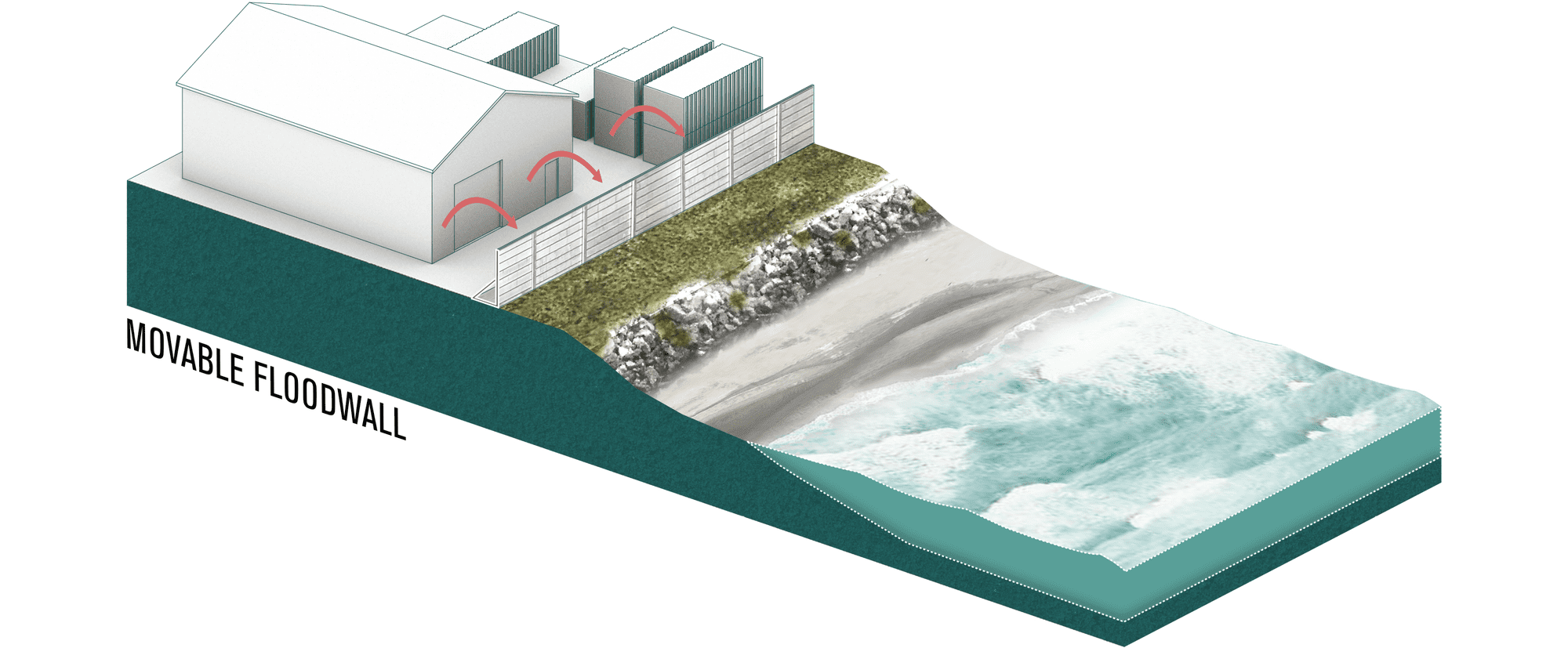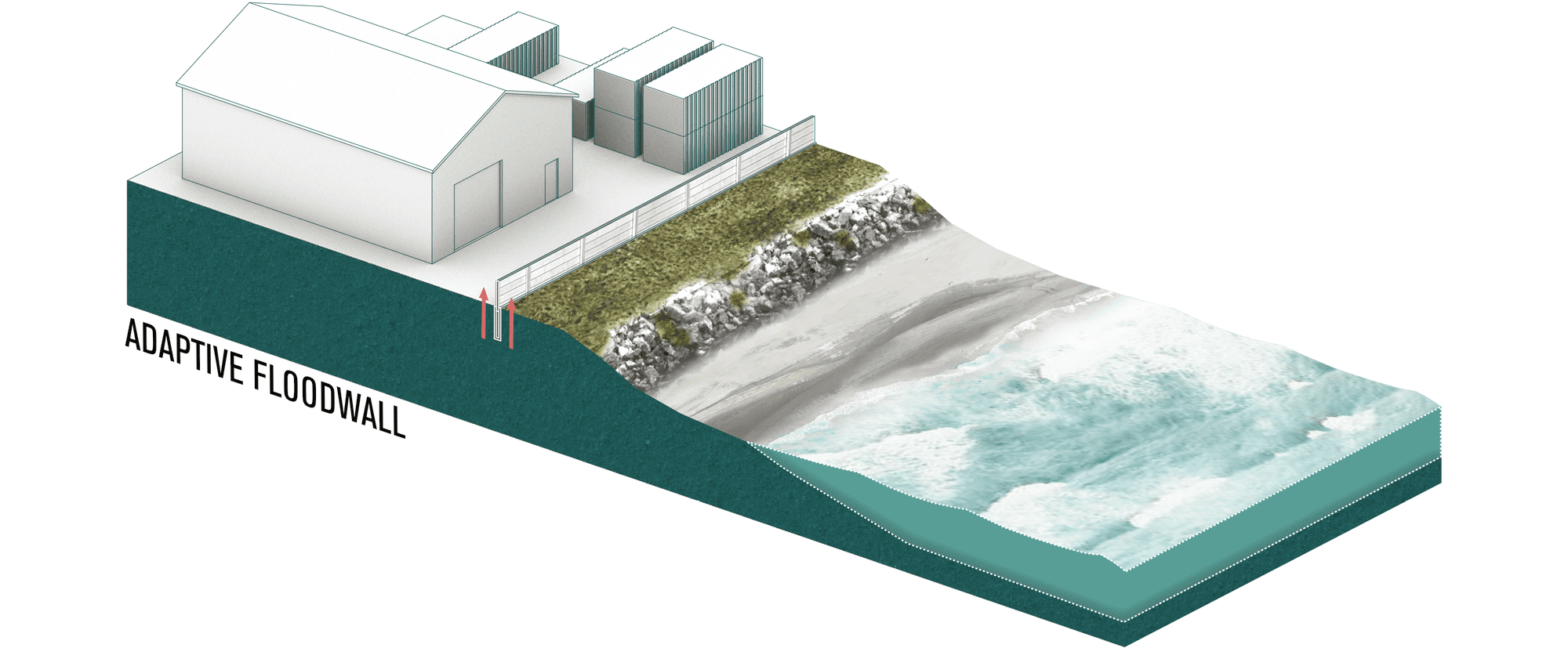Adaptation Strategy: Floodwalls
Floodwalls are typically vertical structural barriers that are used in locations where space is limited due to buildings or other land uses.1 The size of floodwalls can vary from 1 ft to over 20 ft in height. They are usually constructed around buildings or other infrastructure that are below flood levels.2 Floodwalls can be more visually appealing compared to other protection structures. Additionally, they can be constructed using a variety of materials and methods to fit with the surrounding landscape and architectural character. Ultimately, the effectiveness of a floodwall is determined by the size of the storms and the technical characteristic of the wall.
How it works
Types of floodwalls
- Gravity Floodwalls: a gravity floodwall derives structural stability from its weight. This is attained by effectively organizing the mass of the wall from the base, to support the weight of the materials at top of the wall. Gravity flood walls are easy to construct however they require a large quantity of materials.
- Buttress and Counterfort Floodwalls differ based on the position of their transverse support wall. The transverse support wall is on the heel side of a buttressed wall, opposite to any retained materials. In the case of a counterfort wall, the transverse support wall is on the toe side.
- Cantilever floodwalls Constructed mostly using concrete, cantilever floodwalls utilize a cantilever action to restrict any mass behind the wall. It is the most common floodwall because it is economical to design and construct. 10
Benefits
- Mitigates against flood damage in areas with high biodiversity and economic and recreational value
- Provides protection from flooding and hence reduces potential physical and economic impacts on infrastructure and livelihoods
- Reduces the need for alternative flood risk management strategies, e.g., community resettlement.
- Complements other flood risk strategies, e.g., wetland restoration
- Possess the capacity to withstand significant flood loads
Challenges
- Can lead to unintended consequences on local ecosystems and water flows. For example, flood walls may increase water flow in other areas.
- Might be breached or toppled during an extreme flood event; increasing the damage from floodwaters.
- Overtopping can cause scouring and loss of structural support on the passive side
- During a flood event, a flood side gap may be formed resulting in a fully hydrostatic head along the wall face to the depth of the crack 11 12
Example projects
Kings Lynn Flood Gate
The Kings Lynn Flood Gate was a response to the flooding of 1978 caused by a North Sea storm surge.3 Sixty flood gates and barriers were constructed. The wall proved to be effective in 2013 during a storm surge, however, upgrades were necessary for future storms.4 As part of the Environment Agency scheme, Flood Control International replaced over sixty gates and installed 30 new gates and barriers that were more effective.5 One of the interesting features of the new flood gates is a seating area that emerges as the gates pivot downward when there is no flooding.
Britannia Shipyard Floodwall
Richmond BC, Canada
As a response to the large flood of 2016, the City of Richmond constructed a 250-meter-long, 2.9-meter-high floodwall for the Britannia Shipyards; a historical site that falls outside the existing dike system.6 The wall is made up of a vinyl sheet pile with wooden cladding and sections that are open to allow walkway access into the site.7 During a storm surge, the sections are closed off by aluminum flood panels to ensure the complete length of the wall is water-tight.8 The floodwall is part of Richmond’s $300 million Dike Master Plan to reinforce the existing Richmond Dike System over 80 years.9
Citations
-
1.
↑
The Arlington Group Planning Architecture Inc., et al. Sea Level Rise Adaptation Primer. pp. 69. https://www2.gov.bc.ca/assets/gov/environment/climate-change/adaptation/resources/slr-primer.pdf
-
2.
↑
FEMA. Selecting Appropriate Mitigation Measures for Flood prone Structures. 1 Mar. 2007, pp. 2. https://www.fema.gov/media-library-data/20130726-1608-20490-6445/fema551_ch_05.pdf.
-
3.
↑
“King’s Lynn Flood Gate Replacement and Refurbishment.” King's Lynn Flood Gate Replacement and Refurbishment - Case Study, http://www.floodcontrolinternational.com/CASE-STUDIES/case-study-kings-lynn.html.
-
4.
↑
Ibid.
-
5.
↑
Ibid.
-
6.
↑
Wood, Graeme. “Steveston Site Gets a Bigger Flood Wall.” Richmond News, 8 Jan. 2018, https://www.richmond-news.com/news/steveston-site-gets-a-bigger-flood-wall-1.23138686.
-
7.
↑
Ibid.
-
8.
↑
Ibid.
-
9.
↑
Wood, Graeme. “Richmond's $300 Million Dyke Plan Forges Ahead.” Richmond News, 13 Apr. 2017, https://www.richmond-news.com/news/richmond-s-300-million-dyke-plan-forges-ahead-1.15299874.
-
10.
↑
FREIE UNIVERSITÄT BERLIN. Department of Earth Sciences. Floodwalls. INTEGRATED WATER RESOURCE MANAGEMENT - FROM TRADITIONAL KNOWLEDGE TO MODERN TECHNIQUES: https://www.geo.fu-berlin.de/en/v/iwrm/Implementation/technical_measures/Flood-protection-measures/structural_measures/Floodwalls/index.html
-
11.
↑
Bureau of Reclamation. (2020). Risk Management. Best Practices and Risk Methodology. https://www.usbr.gov/ssle/damsafety/risk/methodology.html
-
12.
↑
US Army Corps of Engineers. (2017). Floodwalls
-
13.
↑
Best Practices in Dam and Levee Safety Risk Analysis. https://www.usbr.gov/ssle/damsafety/risk/BestPractices/Presentations/E8-FloodwallsPP.pdf
-
i1.
↑
Flood Gates That Accommodate Seating. http://www.floodcontrolinternational.com/CASE-STUDIES/Resources/KL-bench-gate1.jpg.
-
i2.
↑
The City of Richmond Has Built a Bigger Flood Wall for Britannia Shipyards. https://images.glaciermedia.ca/polopoly_fs/1.23138688.1515437941!/fileImage/httpImage/image.jpg_gen/derivatives/landscape_804/shipyards-wall.jpg.
-
i3.
↑
Figure 1 English, T. (2016). Mobile Flood Walls Keep This Austrian Town Safe. https://interestingengineering.com/mobile-flood-walls-keeps-austrian-town-safe


